Ismini Lourentzou
mTSBench: Benchmarking Multivariate Time Series Anomaly Detection and Model Selection at Scale
Jun 26, 2025Abstract:Multivariate time series anomaly detection (MTS-AD) is critical in domains like healthcare, cybersecurity, and industrial monitoring, yet remains challenging due to complex inter-variable dependencies, temporal dynamics, and sparse anomaly labels. We introduce mTSBench, the largest benchmark to date for MTS-AD and unsupervised model selection, spanning 344 labeled time series across 19 datasets and 12 diverse application domains. mTSBench evaluates 24 anomaly detection methods, including large language model (LLM)-based detectors for multivariate time series, and systematically benchmarks unsupervised model selection techniques under standardized conditions. Consistent with prior findings, our results confirm that no single detector excels across datasets, underscoring the importance of model selection. However, even state-of-the-art selection methods remain far from optimal, revealing critical gaps. mTSBench provides a unified evaluation suite to enable rigorous, reproducible comparisons and catalyze future advances in adaptive anomaly detection and robust model selection.
HalluSegBench: Counterfactual Visual Reasoning for Segmentation Hallucination Evaluation
Jun 26, 2025Abstract:Recent progress in vision-language segmentation has significantly advanced grounded visual understanding. However, these models often exhibit hallucinations by producing segmentation masks for objects not grounded in the image content or by incorrectly labeling irrelevant regions. Existing evaluation protocols for segmentation hallucination primarily focus on label or textual hallucinations without manipulating the visual context, limiting their capacity to diagnose critical failures. In response, we introduce HalluSegBench, the first benchmark specifically designed to evaluate hallucinations in visual grounding through the lens of counterfactual visual reasoning. Our benchmark consists of a novel dataset of 1340 counterfactual instance pairs spanning 281 unique object classes, and a set of newly introduced metrics that quantify hallucination sensitivity under visually coherent scene edits. Experiments on HalluSegBench with state-of-the-art vision-language segmentation models reveal that vision-driven hallucinations are significantly more prevalent than label-driven ones, with models often persisting in false segmentation, highlighting the need for counterfactual reasoning to diagnose grounding fidelity.
Open World Scene Graph Generation using Vision Language Models
Jun 09, 2025Abstract:Scene-Graph Generation (SGG) seeks to recognize objects in an image and distill their salient pairwise relationships. Most methods depend on dataset-specific supervision to learn the variety of interactions, restricting their usefulness in open-world settings, involving novel objects and/or relations. Even methods that leverage large Vision Language Models (VLMs) typically require benchmark-specific fine-tuning. We introduce Open-World SGG, a training-free, efficient, model-agnostic framework that taps directly into the pretrained knowledge of VLMs to produce scene graphs with zero additional learning. Casting SGG as a zero-shot structured-reasoning problem, our method combines multimodal prompting, embedding alignment, and a lightweight pair-refinement strategy, enabling inference over unseen object vocabularies and relation sets. To assess this setting, we formalize an Open-World evaluation protocol that measures performance when no SGG-specific data have been observed either in terms of objects and relations. Experiments on Visual Genome, Open Images V6, and the Panoptic Scene Graph (PSG) dataset demonstrate the capacity of pretrained VLMs to perform relational understanding without task-level training.
LaTtE-Flow: Layerwise Timestep-Expert Flow-based Transformer
Jun 08, 2025Abstract:Recent advances in multimodal foundation models unifying image understanding and generation have opened exciting avenues for tackling a wide range of vision-language tasks within a single framework. Despite progress, existing unified models typically require extensive pretraining and struggle to achieve the same level of performance compared to models dedicated to each task. Additionally, many of these models suffer from slow image generation speeds, limiting their practical deployment in real-time or resource-constrained settings. In this work, we propose Layerwise Timestep-Expert Flow-based Transformer (LaTtE-Flow), a novel and efficient architecture that unifies image understanding and generation within a single multimodal model. LaTtE-Flow builds upon powerful pretrained Vision-Language Models (VLMs) to inherit strong multimodal understanding capabilities, and extends them with a novel Layerwise Timestep Experts flow-based architecture for efficient image generation. LaTtE-Flow distributes the flow-matching process across specialized groups of Transformer layers, each responsible for a distinct subset of timesteps. This design significantly improves sampling efficiency by activating only a small subset of layers at each sampling timestep. To further enhance performance, we propose a Timestep-Conditioned Residual Attention mechanism for efficient information reuse across layers. Experiments demonstrate that LaTtE-Flow achieves strong performance on multimodal understanding tasks, while achieving competitive image generation quality with around 6x faster inference speed compared to recent unified multimodal models.
Uncertainty in Action: Confidence Elicitation in Embodied Agents
Mar 13, 2025Abstract:Expressing confidence is challenging for embodied agents navigating dynamic multimodal environments, where uncertainty arises from both perception and decision-making processes. We present the first work investigating embodied confidence elicitation in open-ended multimodal environments. We introduce Elicitation Policies, which structure confidence assessment across inductive, deductive, and abductive reasoning, along with Execution Policies, which enhance confidence calibration through scenario reinterpretation, action sampling, and hypothetical reasoning. Evaluating agents in calibration and failure prediction tasks within the Minecraft environment, we show that structured reasoning approaches, such as Chain-of-Thoughts, improve confidence calibration. However, our findings also reveal persistent challenges in distinguishing uncertainty, particularly under abductive settings, underscoring the need for more sophisticated embodied confidence elicitation methods.
FAIR: Facilitating Artificial Intelligence Resilience in Manufacturing Industrial Internet
Mar 03, 2025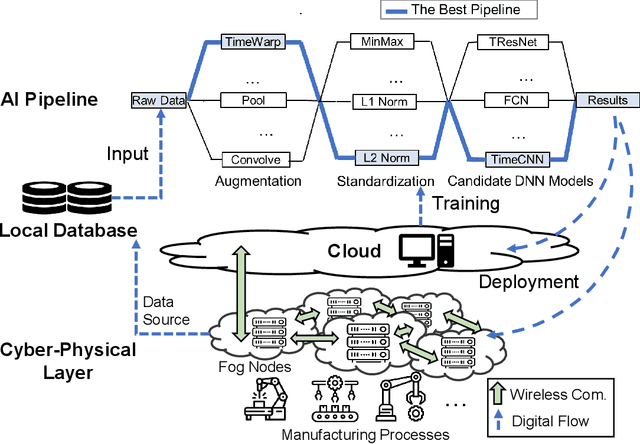

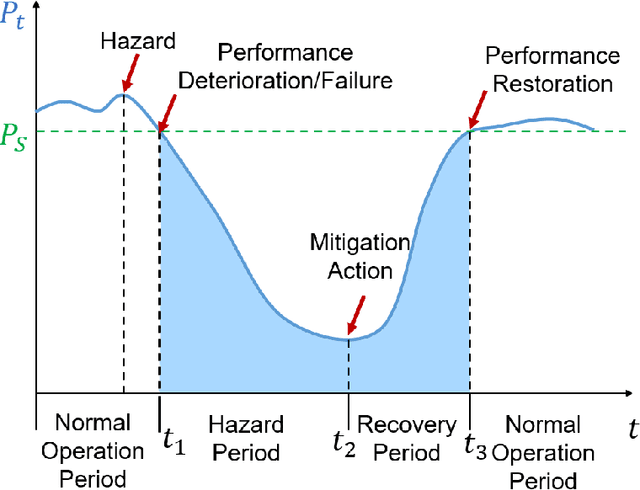
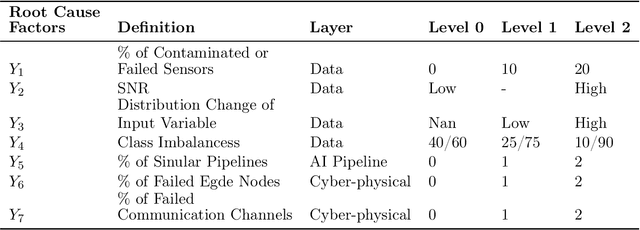
Abstract:Artificial intelligence (AI) systems have been increasingly adopted in the Manufacturing Industrial Internet (MII). Investigating and enabling the AI resilience is very important to alleviate profound impact of AI system failures in manufacturing and Industrial Internet of Things (IIoT) operations, leading to critical decision making. However, there is a wide knowledge gap in defining the resilience of AI systems and analyzing potential root causes and corresponding mitigation strategies. In this work, we propose a novel framework for investigating the resilience of AI performance over time under hazard factors in data quality, AI pipelines, and the cyber-physical layer. The proposed method can facilitate effective diagnosis and mitigation strategies to recover AI performance based on a multimodal multi-head self latent attention model. The merits of the proposed method are elaborated using an MII testbed of connected Aerosol Jet Printing (AJP) machines, fog nodes, and Cloud with inference tasks via AI pipelines.
CALICO: Part-Focused Semantic Co-Segmentation with Large Vision-Language Models
Dec 26, 2024Abstract:Recent advances in Large Vision-Language Models (LVLMs) have sparked significant progress in general-purpose vision tasks through visual instruction tuning. While some works have demonstrated the capability of LVLMs to generate segmentation masks that align phrases with natural language descriptions in a single image, they struggle with segmentation-grounded comparisons across multiple images, particularly at finer granularities such as object parts. In this paper, we introduce the new task of part-focused semantic co-segmentation, which seeks to identify and segment common and unique objects and parts across images. To address this task, we present CALICO, the first LVLM that can segment and reason over multiple masks across images, enabling object comparison based on their constituent parts. CALICO features two proposed components, a novel Correspondence Extraction Module, which captures semantic-rich information to identify part-level correspondences between objects, and a Correspondence Adaptation Module, which embeds this information into the LVLM to facilitate multi-image understanding in a parameter-efficient manner. To support training and evaluation, we curate MixedParts, a comprehensive multi-image segmentation dataset containing $\sim$2.4M samples across $\sim$44K images with diverse object and part categories. Experimental results show CALICO, finetuned on only 0.3% of its architecture, achieves robust performance in part-focused semantic co-segmentation.
PRIMA: Multi-Image Vision-Language Models for Reasoning Segmentation
Dec 19, 2024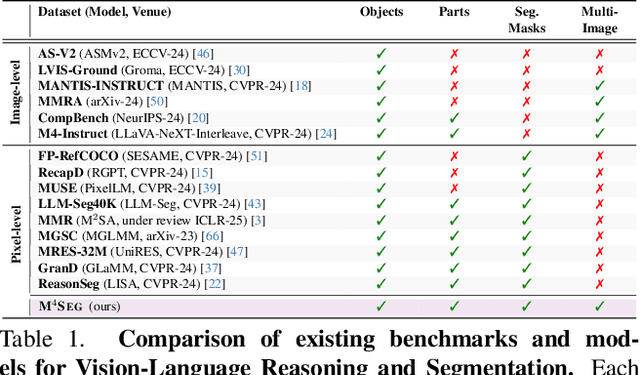
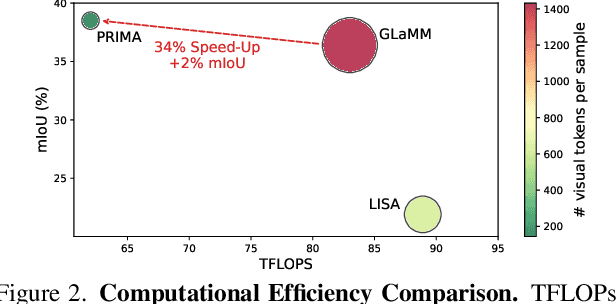
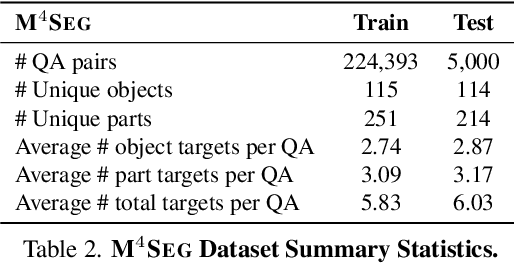
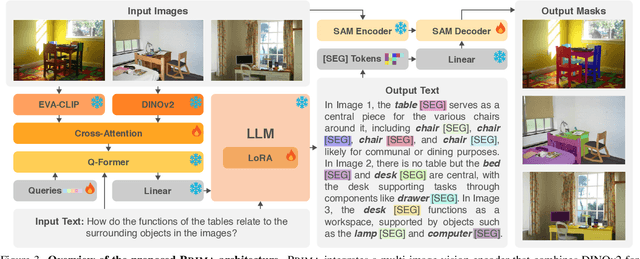
Abstract:Despite significant advancements in Large Vision-Language Models (LVLMs), existing pixel-grounding models operate on single-image settings, limiting their ability to perform detailed, fine-grained comparisons across multiple images. Conversely, current multi-image understanding models lack pixel-level grounding. Our work addresses this gap by introducing the task of multi-image pixel-grounded reasoning segmentation, and PRIMA, a novel LVLM that integrates pixel-level grounding with robust multi-image reasoning capabilities to produce contextually rich, pixel-grounded explanations. Central to PRIMA is an efficient vision module that queries fine-grained visual representations across multiple images, reducing TFLOPs by $25.3\%$. To support training and evaluation, we curate $M^4Seg$, a new reasoning segmentation benchmark consisting of $\sim$224K question-answer pairs that require fine-grained visual understanding across multiple images. Experimental results demonstrate PRIMA outperforms state-of-the-art baselines.
Context Canvas: Enhancing Text-to-Image Diffusion Models with Knowledge Graph-Based RAG
Dec 12, 2024Abstract:We introduce a novel approach to enhance the capabilities of text-to-image models by incorporating a graph-based RAG. Our system dynamically retrieves detailed character information and relational data from the knowledge graph, enabling the generation of visually accurate and contextually rich images. This capability significantly improves upon the limitations of existing T2I models, which often struggle with the accurate depiction of complex or culturally specific subjects due to dataset constraints. Furthermore, we propose a novel self-correcting mechanism for text-to-image models to ensure consistency and fidelity in visual outputs, leveraging the rich context from the graph to guide corrections. Our qualitative and quantitative experiments demonstrate that Context Canvas significantly enhances the capabilities of popular models such as Flux, Stable Diffusion, and DALL-E, and improves the functionality of ControlNet for fine-grained image editing tasks. To our knowledge, Context Canvas represents the first application of graph-based RAG in enhancing T2I models, representing a significant advancement for producing high-fidelity, context-aware multi-faceted images.
uaMix-MAE: Efficient Tuning of Pretrained Audio Transformers with Unsupervised Audio Mixtures
Mar 14, 2024Abstract:Masked Autoencoders (MAEs) learn rich low-level representations from unlabeled data but require substantial labeled data to effectively adapt to downstream tasks. Conversely, Instance Discrimination (ID) emphasizes high-level semantics, offering a potential solution to alleviate annotation requirements in MAEs. Although combining these two approaches can address downstream tasks with limited labeled data, naively integrating ID into MAEs leads to extended training times and high computational costs. To address this challenge, we introduce uaMix-MAE, an efficient ID tuning strategy that leverages unsupervised audio mixtures. Utilizing contrastive tuning, uaMix-MAE aligns the representations of pretrained MAEs, thereby facilitating effective adaptation to task-specific semantics. To optimize the model with small amounts of unlabeled data, we propose an audio mixing technique that manipulates audio samples in both input and virtual label spaces. Experiments in low/few-shot settings demonstrate that \modelname achieves 4-6% accuracy improvements over various benchmarks when tuned with limited unlabeled data, such as AudioSet-20K. Code is available at https://github.com/PLAN-Lab/uamix-MAE
 Add to Chrome
Add to Chrome Add to Firefox
Add to Firefox Add to Edge
Add to Edge